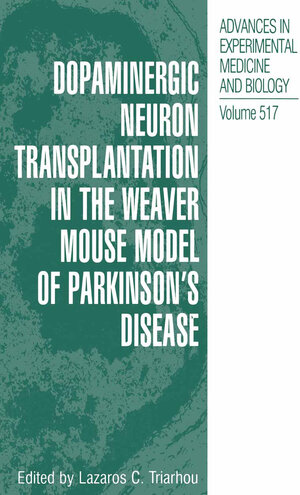
×
![Buchcover ISBN 9781461506997]()
Dopaminergic Neuron Transplantation in the Weaver Mouse Model of Parkinson’s Disease
von Lazaros C. TriarhouInhaltsverzeichnis
- 1. Introduction.
- Dopamine and Parkinson’s Disease.
- Experimental Models of Parkinsonism in Laboratory Animals.
- Graft-Assisted Neural Reconstruction (“Brainware Engineering”?).
- References.
- 2. Biology And Pathology of the Weaver Mutant Mouse.
- Cellular and Molecular Genetics of the Weaver Mutation.
- Alterations of the Mesotelencephalic Dopamine Projection System.
- Cerebellar Phenotype of the Weaver Mutant.
- Hippocampal Morphology.
- Biology of Normal ? Mutant Cell Associations.
- Behavioral Phenotype.
- Structural Clues to the Weaver Riddle.
- 3. Histochemical Properties of Intrastriatal Mesencephalic Grafts.
- Methodological Considerations.
- Expression of Catecholaminergic Neurotransmitter-Related Molecules and Quantitative Aspects of Dopaminergic Neuron Survival.
- Comparative Survival of Dopaminergic Neurons in Grafts Placed in Weaver and in 6-OHDA Lesion Hosts.
- Expression of Neuropeptides and Structural Proteins.
- 4. Structural Correlates of Process Outgrowth and Circuit Reconstruction.
- Axonal Reinnervation of the Host Striatum.
- Synaptic Investment of Graft-Derived Dopamine Terminals.
- Compartmental Specificity of the Striatal Reinnervation.
- Innervation of Nonstriatal Regions by the Grafts.
- Chemoaffinity and Axon-Target Recognition in Development and in Transplantation.
- Dendrite Extension from the Graft into the Host Striatum.
- Expression of Molecules Related to Axonal and Dendritic Outgrowth.
- 5. Neurochemical Indices of Functional Restoration.
- Dopamine Uptake Markers.
- Autoradiography of [3H]Dopamine Uptake.
- Dopamine Receptors.
- Neurotensin Receptors.
- Excitatory and Inhibitory Amino Acid Receptors.
- 6. Behavioral Recovery of Functional Responses.
- Unilateral Grafts and Circling Behavior.
- Correlationof Turning Bias with Structural and Biochemical Parameters.
- Dissociation of the Functional Contribution of Graft-Derived Axons and Dendrites in Rotational Asymmetry.
- Enhancement of Motor Performance after Bilateral Transplantation.
- 7. Directions for Future Research.
- Analysis of Early Events in Graft-Host Interactions.
- Trophic Considerations.
- Neurotransmitter Mechanisms.
- Supplemental Restoration of the Interrupted Nigro-Striato-Nigral Loop by Striatal/Nigral Double Grafts.



